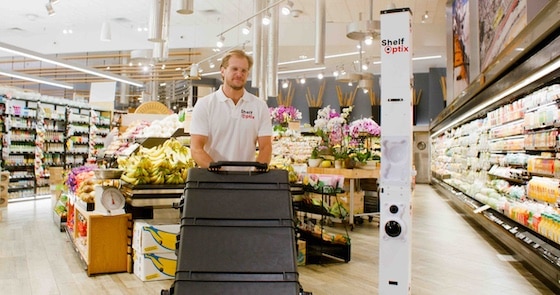An emerging trend we continue to track is the convergence of AI and computer vision to unlock insights in the physical world. This extends AI’s domain beyond the web – where it primarily resides – to the broader canvas of the physical world. And one place that’s happening is your local grocery store.
As we examined with Augmodo and Auki Labs, the idea is to scan store aisles to reveal what’s on the shelf. The resulting digital twins unlock insights that can help retailers with inventory management. They can also optimize store shelves and layouts, similar to the ways you’d optimize a web page.
Another way to look at this is to index the physical world – in this case, the products that sit on a retailer’s shelves. Once indexed, they become searchable, just like it’s done on the interweb. Maintaining a real-time index can then lead to outcomes like real-time physical product search for shoppers.
Building on this thread, the latest player to blip on our radar screen is ShelfOptix. The company specializes in all the above – a field that it has coined “shelf intelligence.” Like Augmodo and Auki, it scans store shelves to digitize physical-world data and create digital twins of retail store shelves.
Raising the Stakes
Though the end goal is common among these players, the methodology is different. For example, Augmodo uses lanyard scanners, strapped to store associates for “passive scanning.” Auki uses commodity hardware (existing smartphones). ShelfOptix raises the stakes with robots.
These are wheeled pedestal-shaped robots that autonomously roam store aisles to do their thing. Think of it like a Roomba but taller, so it can get full-length aisle scans. The result, like Augmodo and Auki, is comprehensive spatial maps of store aisles and shelves, from which insights and optimization can flow.
One value of these scans, according to ShelfOptix, is ‘ground truth shelf visibility.’ This means it can reveal things like ‘sales blockers’ or other issues overlooked by human eyes. If those insights are gleaned and acted on properly, possibilities include tangible bottom-line results or preventing lost revenue.
For example, on the lost-revenue point, ShelfOptix estimates that 70 percent of consumers switch retailers or brands when they see out-of-stock items on a given shelf. Translating that to dollars, out-of-stock products and “phantom inventory” cost the retail sector $1.7 trillion in annual lost revenue.
Retailer Resistance
Beyond using robots, another point of differentiation for ShelfOptix is its pricing and delivery. Rather than sell robots to retailers, it offers a managed service. Retailers get a turnkey system with hardware, software, and SaaS-like pricing. Altogether, this reduces friction and makes the whole thing digestible.
This is practical, given the retailer resistance that ShelfOptix has likely anticipated. Retailers can be innovative, but it’s generally a vertical that’s low on the tech adoption scale. Considering the capital expenditure of robots, it adds up to a tough sell. So a low-commitment SaaS-like approach is smart.
Adding to the list of sales challenges, there’s still local-business mistrust of AI, as our research indicates. And that mistrust is mostly in AI’s digital forms – lying safely behind all your screens. Robots raise an elevated manifestation of AI, and thus the magnitude of the cultural fears that surround it.
That’s not to say that ShelfOptix is doomed, but that it will face headwinds. Regardless of our speculation, what really matters is what the free market thinks. Those demand signals are evident, including deals with Winn-Dixie and Harvey’s Supermarkets. We’ll watch closely to see who else bites.




